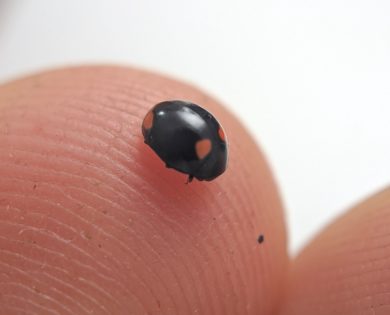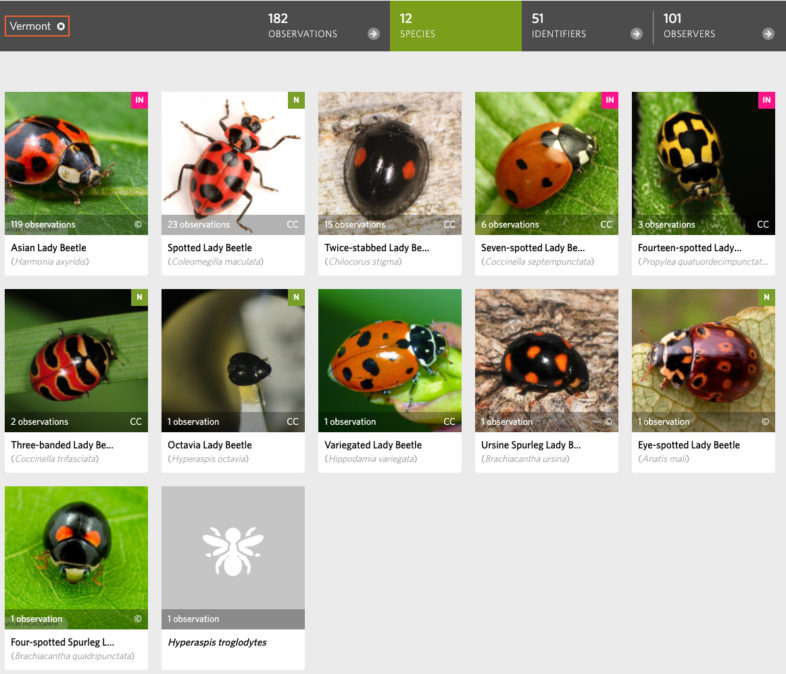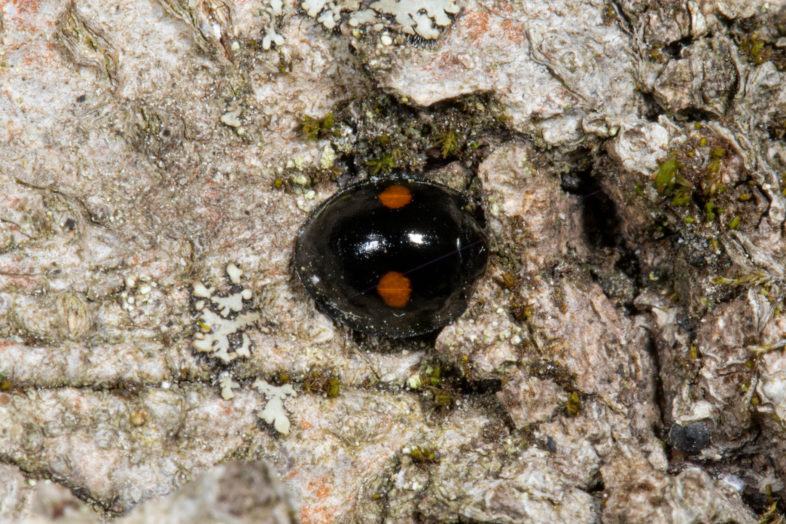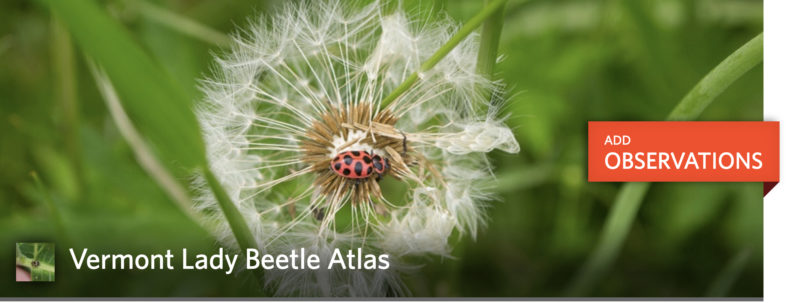On May 15th the weekend long Vermont Backyard Lady Beetle Blitz had just kicked off. VCE biologist Spencer Hardy was positioned on Snake Mountain with net in hand scouring a patch of blooming toothwort for a specialist bee—the Mustard Miner Bee (Andrena arabis)—and searching for lady beetles.

A tiny Four-spotted Spurleg Lady Beetle found by Spencer Hardy. Click on the image to view the observation on iNaturalist.
“I swung at a bee and had it in the net briefly before it escaped, but I noticed a tiny black and red beetle just sitting on my net,” said Hardy. Not recognizing the lady beetle species right away, he scooped it into a vial to examine later and continued his search for bees and beetles. Only later when he was able to examine the beetle closely did he realize he was holding one of Vermont’s lost lady beetles—Four-spotted Spurleg Lady Beetle (Brachiacantha quadripunctata)—a species that hasn’t been found since 1976.
Over 100 Biologists and citizen scientists have photographed and reported more than 183 lady beetle observations representing perhaps a dozen species to the Vermont Lady Beetle Atlas just since its inception this spring. Unfortunately, three of those species are introduced, including over 100 reports of the ubiquitous Asian Lady Beetle (Harmonia axyridis)—often found in and around or homes— and along with other introduced species, may be responsible for some of the losses of our native fauna.

Lady beetle observations reported to the Vermont Atlas of Life this spring. Click on the image to explore them more on iNaturalist.
For native species, observers have reported mostly Spotted Lady Beetle (Coleomegilla maculata) and Twice-stabbed Lady Beetle (Chilocorus stigma) this spring. Spotted are often found early in the season on flowers, like Common Dandelions, feeding on pollen. Carefully examine a few beech trunks and you’re likely to find a Twice-stabbed Lady Beetle, aptly named for the two bright red spots on each side of its black elytra, feeding on Beech Bark Scale. Here in the north, overwintering adults become active in early spring (April) when mating begins. They lay eggs soon after mating and the larvae emerge in late May. They feed and undergo four instars before pupating. The adults that overwintered will continue to feed through June and early July. Their young mature in early to mid July, and then they mate and lay eggs. Finally, second generation larvae are observed beginning in mid July through early August. These second generation adults emerge in late summer and early fall and overwinter in ground litter.

Twice-stabbed Lady Beetle (Chilocorus stigma) on an American Beech trunk. K.P. McFarland licensed under CC-BY-NC
Last year, alarm bells started going off as we sifted through historic lady beetle collections from the University of Vermont Zadock Thompson Natural History Collection, Middlebury College, and the Vermont Forest, Parks, and Recreation collection, and modern records from the Vermont Atlas of Life iNaturalist project and the Lost Ladybug Project at Cornell University as well. As the pieces fell into place, we realized that 13 of Vermont’s 33 native lady beetle species have been missing since the 1970s. This may come as a surprise to anyone who has watched armies of bright red and orange beetles invade their windowsills once the autumn wind catches a chill. However, most of these winter roommates are in fact an invasive species—the Asian Lady Beetle—thought to be partly responsible for the native species’ declines.
Although it may appear that Asian Lady Beetles are all there is to see, look more closely at the plants near your home and you may notice other lady beetles who often blend in. A friend to farmers and gardeners alike, these tiny insects feed primarily on aphids and other pests who can destroy crops. Healthy, diverse lady beetle populations keep these pests in check, making the decline and disappearance of some native species quite concerning.
The Vermont Lady Beetle Atlas was created to find answers to the questions regarding these missing species’ whereabouts. The Atlas’s main objective is to collect information about Vermont’s lady beetle species by conducting field surveys and revisiting older records in order to develop a deeper understanding of how they are faring. However, VCE cannot undertake this endeavor alone. Its as easy as search, photograph, and upload– to the Vermont Lady Beetle Atlas. Please join us!


Way to go, Spencer!
Wow, that is sobering indeed! I am not in Vermont, but think this blog and the center’s programming is fantastic (still trying to find an easy way to subscribe). I have spent a lot of time studying the impacts of non-native invasive plants, but am just now beginning to realize that we have made “biological stew” on many levels, from insects, to slugs, to algae, to earthworms. Is the horse out of the barn? I don’t know, but will actively work to make sure there is still room for the plant species the native ecology relies upon as its foundation. Thanks for all your work in education! I am in Cape Breton Nova Scotia, where nothing like this is happening…don’t have a population base for it, so thanks for educating everyone!
Hi I found a black with two red spots ladybug I have no clue until now im native American and this is so awesome
That is so cool! Depending on where you are, there are several with just two red spots. One that is around here and often easy to find on beech trees is this one: https://val.vtecostudies.org/projects/lady-beetle-atlas/twice-stabbed-lady-beetle/
I live in Illinois and have seen dozens of black lady beetles with four faint red spots in our backyard. I thought they were ticks until I came across this site!
I live in Scotland and I found one of these ladybugs today black with 4 red spots on it
I found something on my milkweed patch (Burlington) that looks very like your Four-spotted spurleg, but I only have a side view. Is there a way I can submit a photo?
You can submit this image, and really anything you find, to our Vermont Atlas of Life project at iNaturalist. https://www.inaturalist.org/projects/vermont-atlas-of-life. It is really fun to use and there are smart phone apps too!